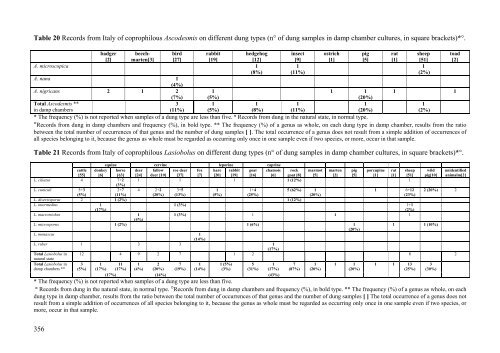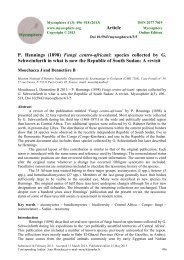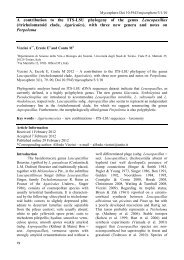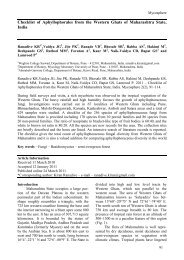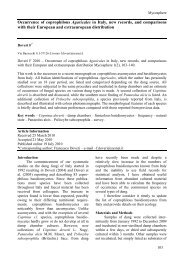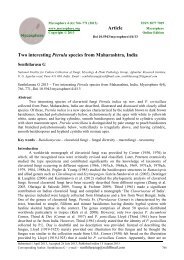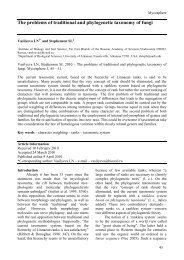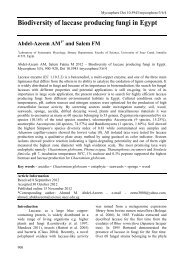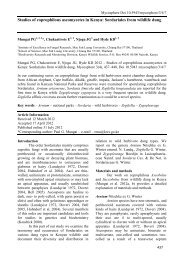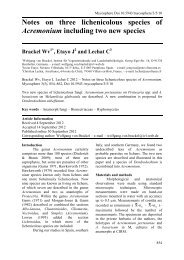Fungi Fimicoli Italici - Mycosphere-online journal
Fungi Fimicoli Italici - Mycosphere-online journal
Fungi Fimicoli Italici - Mycosphere-online journal
Create successful ePaper yourself
Turn your PDF publications into a flip-book with our unique Google optimized e-Paper software.
Table 20 Records from Italy of coprophilous Ascodesmis on different dung types (n° of dung samples in damp chamber cultures, in square brackets)*°.<br />
badger beech- bird rabbit hedgehog insect ostrich pig rat sheep toad<br />
[2] marten[3] [27]<br />
[19]<br />
[12]<br />
[9]<br />
[1]<br />
[5] [1] [51] [2]<br />
A. microscopica 1<br />
1<br />
1<br />
(8%)<br />
(11%)<br />
(2%)<br />
A. nana 1<br />
(4%)<br />
A. nigricans 2 1 2<br />
1<br />
1 1 1 1<br />
(7%) (5%)<br />
(20%)<br />
Total Ascodesmis **<br />
3<br />
1<br />
1<br />
1<br />
1<br />
1<br />
in damp chambers<br />
(11%) (5%)<br />
(8%)<br />
(11%)<br />
(20%)<br />
(2%)<br />
* The frequency (%) is not reported when samples of a dung type are less than five. ° Records from dung in the natural state, in normal type.<br />
°Records from dung in damp chambers and frequency (%), in bold type. ** The frequency (%) of a genus as whole, on each dung type in damp chamber, results from the ratio<br />
between the total number of occurrences of that genus and the number of dung samples [ ]. The total occurrence of a genus does not result from a simple addition of occurrences of<br />
all species belonging to it, because the genus as whole must be regarded as occurring only once in one sample even if two species, or more, occur in that sample.<br />
Table 21 Records from Italy of coprophilous Lasiobolus on different dung types (n° of dung samples in damp chamber cultures, in square brackets)*°.<br />
equine cervine leporine caprine<br />
cattle donkey horse deer fallow roe deer fox hare rabbit goat chamois rock marmot marten pig porcupine rat sheep wild unidentified<br />
[55] [6] [63] [24] deer [10] [37] [7] [20] [19] [16] [6] goat [8] [5] [2] [5] [1] [1] [51] pig[10] animalm[2]<br />
L. ciliatus 4 7+2<br />
(3%)<br />
1 1 1 1 (12%) 1<br />
L. cuniculi 5+3<br />
2+7 4 2+2 3+5<br />
1<br />
1+4<br />
5 (62%) 1<br />
1 6+12 2 (20%) 2<br />
(5%)<br />
(11%)<br />
(20%) (13%)<br />
(5%)<br />
(25%)<br />
(20%)<br />
(23%)<br />
L. diversisporus 2 1 (2%) 1 (12%)<br />
L. intermedius 1<br />
1 (3%) 1+1<br />
(17%)<br />
(2%)<br />
L. macrotrichus 1<br />
(4%)<br />
1 (3%) 1 1 1<br />
L. microsporus 1 (2%) 1 (6%) 1<br />
(20%)<br />
1 1 (10%)<br />
L. monascus 1<br />
(14%)<br />
L. ruber 1 3 3 1<br />
(17%)<br />
Total Lasiobolus in<br />
natural state<br />
12 4 9 2 7 1 2 8 2<br />
Total Lasiobolus in 3 1 11 1 2 7 1 1 (5%) 5 1 7 1 1 1 1 1 13 3<br />
damp chambers ** (5%) (17%) (17%) (4%) (20%) (19%) (14%) (3%) (31%) (17%) (87%) (20%)<br />
(20%)<br />
(25%) (30%)<br />
(17%) (14%) (43%)<br />
* The frequency (%) is not reported when samples of a dung type are less than five.<br />
° Records from dung in the natural state, in normal type. °Records from dung in damp chambers and frequency (%), in bold type. ** The frequency (%) of a genus as whole, on each<br />
dung type in damp chamber, results from the ratio between the total number of occurrences of that genus and the number of dung samples [ ] The total occurrence of a genus does not<br />
result from a simple addition of occurrences of all species belonging to it, because the genus as whole must be regarded as occurring only once in one sample even if two species, or<br />
more, occur in that sample.<br />
356


